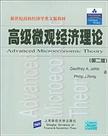高级微观经济理论
出版时间:2001-12 出版社:上海财经大学出版社 作者:Jehle, G.A./ Reny, P.J. 页数:543
Tag标签:无
前言
In every chapter of this new edition, our focus remains on the modem coreof its respective area. We continue to believe that this approach enablesthe careful reader to build a deep understanding of the principal pillars ofmodem microeconomics and to see the connections among them. We aregrateful that so many students and colleagues seem to agree. There are exercises at the end of every chapter, and working throughas many of these as possible is the surest way to master the material. Hintsand answers for selected exercises are provided at the end of the book,along with lists of theorems and definitions appearing in the text. We alsoplan to maintain a Readers Forum on the web, where readers can exchangesolutions to exercises in the text. The Readers Forum can be reached athttp ://alfred. vassar.edu. In preparing this new edition, we have taken the opportunity to makeone major structural change. As more and more students enter graduateprograms better prepared in mathematics, we believed we could safelymove the pure mathematics to an appendix. There, it will still be availablefor those who want a refresher or for those who need to fill a gap in theirpreparation, but it will not stand in the way of instructors who feel theirstudents are prepared to jump right into microeconomic theory from dayone. The two full chapters of the Mathematical Appendix still providestudents with a lengthy and largely self-contained development of the settheory, real analysis, topology, calculus, and modem optimization theory,which are indispensable in modem microeconomics. The exposition isformal but presumes nothing more than a good grounding in single-variablecalculus and simple linear algebra as a starting point. We suggest that evenstudents who are very well-prepared in mathematics browse both chaptersof the appendix early on. That way, if and when some review or referenceis needed, the reader will have a sense of how that material is organized.
内容概要
《高级微观经济理论(第2版)(英文版)》用耳目一新和通俗易读的写作方法严密地阐述了包括消费者理论、生产者理论,以及部分均衡、一般均衡、博弈论和信息等内容的现代微观经济理论。《高级微观经济理论(第2版)(英文版)》所详细介绍的内容不仅具有一定的深度,而且还能帮助读者通过深入了解如何运用微观经济原理来掌握这些复杂的理论。具有三大特色: 新增了“拍卖”这一章节。《高级微观经济理论(第2版)(英文版)》从机制设计的视角出发,向读者介绍了最新的“拍卖”理论。该理论反映了目前最富有活力的理论研究前沿的动向。通过本章的学习,读者能够加深自己对该迅速发展的领域的理解。 新增了数学附录。
书籍目录
前言Ⅰ 经济代理人1 消费者理论1.1 主要概念1.2 偏好与效用1.2.1 偏好关系1.2.2 效用函数1.3 消费者问题1.4 间接效用与支出1.4.1 间接效用函数1.4.2 支出函数1.4.3 间接效用函数与支出函数之间的关系1.5 消费者需求的性质1.5.1 相对价格与实际收入1.5.2 收入效应与替代效应1.5.3 一些弹性关系1.6 习题2 消费者理论专题2.1 对偶性:一个细致的考虑2.1.1 支出与消费者偏好2.1.2 凸性与单调性2.1.3 间接效用与消费者偏好2.2 可积分性2.3 显示性偏好2.4 不确定性2.4.1 偏好2.4.2 冯·诺伊曼-莫根施特效用2.4.3 风险厌恶2.5 习题3 厂商理论3.1 主要概念3.2 生产3.2.1 规模报酬与可变比例3.3 成本3.4 生产中的对偶性3.5 竞争性厂商3.5.1 利润最大化3.5.2 利润函数3.6 习题Ⅱ 市场与福利4 局部均衡4.1 完全竞争4.2 不完全竞争4.2.1 古诺寡头4.2.2 伯川德寡头4.2.3 垄断竞争4.3 均衡与福利4.3.1 价格与个人福利4.3.2 竞争结果的效率4.3.3 效率与总剩余最大化4.4 习题5 一般均衡5.1 交换均衡5.2 竞争性市场体系均衡5.2.1 均衡的存在性5.2.2 效率5.3 生产均衡5.3.1 生产者5.3.2 消费者5.3.3 均衡5.3.4 福利5.4 核与均衡性5.4.1 复制的经济5.5 习题6 社会选择与福利6.1 问题的性质6.2 社会选择与阿罗定理6.2.1 一种图式的证明6.3 可度量性、可比较性与一些可能性6.3.1 罗尔斯形式6.3.2 功利形式6.3.3 可变的形式6.4 公正性6.5 习题Ⅲ 策略性行为7 博奕论8 信息经济学9 拍卖与机制设计数学附录第A1章 集合与映射第A2章 微积分与最优化
章节摘录
Theorem 1.1 is very important. It frees us to represent preferences either in terms ofthe primitive set-theoretic preference relation or in terms of a numerical representation, acontinuous utility function. But this utility representation is never unique. If some func-tion u represents a consumers preferences, then so too will the function v = u + 5, or thefunction v = u3, because each of these functions ranks bundles the same way u does. Thisis an important point about utility functions that must be grasped. If all we require of thepreference relation is that it order the bundles in the consumption set, and if all we requireof a utility function representing those preferences is that it reflect that ordering of bundlesby the ordering of numbers it assigns to them, then any other function that assigns numbersto bundles in the same order as u does will also represent that preference relation and willitself be just as good a utility function as u. This is known by several different names in the literature. People sometimes saythe utility function is invariant to positive monotonic transforms or sometimes they saythat the utility function is unique up to a positive monotonic transform. Either way, themeaning is this: If all we require of the preference relation is that rankings between bun-dles be meaningful, then all any utility function representing that relation is capable ofconveying to us is ordinal information: no more and no less. If we know that one func-tion properly conveys the ordering of bundles, then any transform of that function thatpreserves that ordering of bundles will perform all the duties of a utility function justas well. Seeing the representation issue in proper perspective thus frees us and restrains us.If we have a function u that represents some consumers preferences, it frees us to trans-form u into other, perhaps more convenient or easily manipulated forms, as long as thetransformation we choose is order-preserving. At the same time, we are restrained by theexplicit warning here that no significance whatsoever can be attached to the actual numbersassigned by a given utility function to particular bundles——only to the ordering of thosenumbers.4 This conclusion, though simple to demonstrate, is nonetheless important enoughto warrant being stated formally. The proof is left as an exercise.
编辑推荐
《高级微观经济理论(第2版)(英文版)》通过新添系统的数学附录,希望那些想了解、复习和获取数学基础知识的读者能在完全重新组织改写的这两章中获得其所需的内容。 内容完全更新。《高级微观经济理论(第2版)(英文版)》仔细修订和完全更新了第一版的每一章节的内容。
图书封面
图书标签Tags
无
评论、评分、阅读与下载
